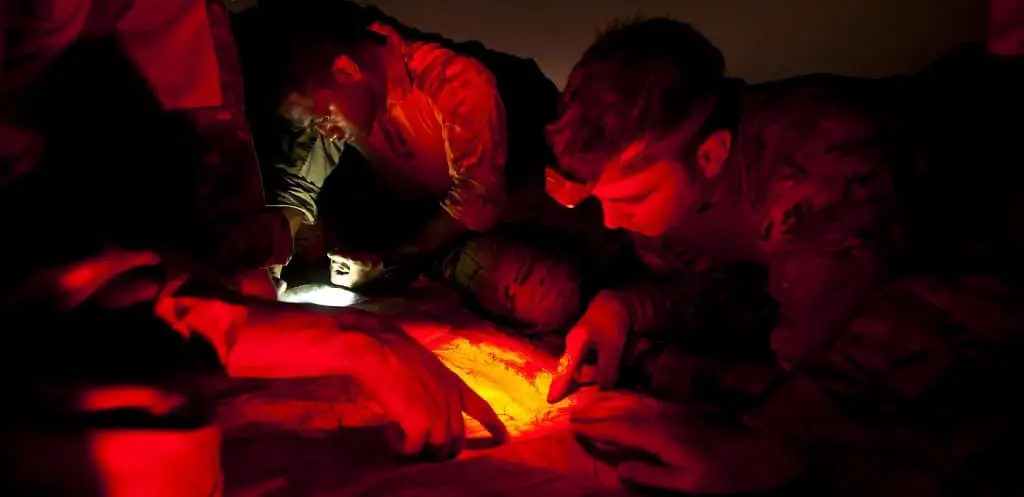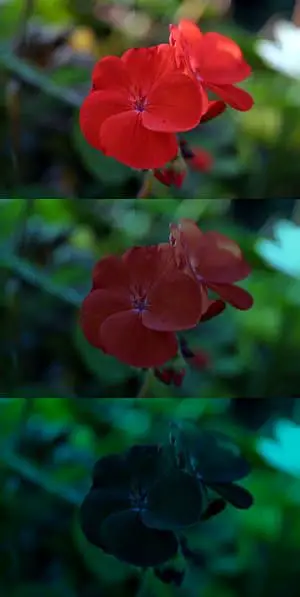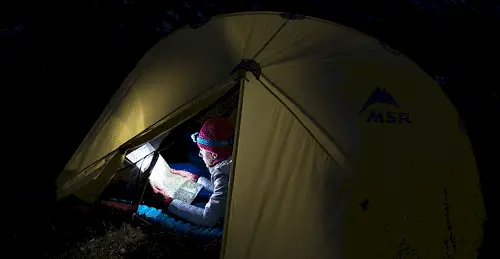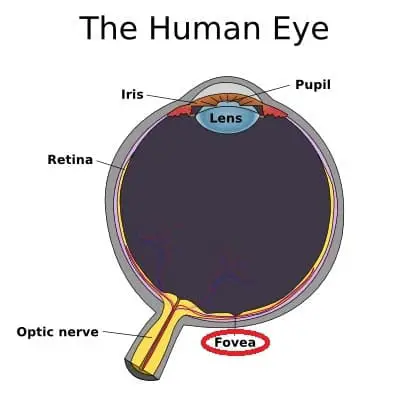When I bought my first headlamp I saw it had three bulbs – two of them were red and in between set the white one, which was also the largest. The head torch had this function which allowed me to switch the beam colors, although I wasn’t sure what was its purpose. For quite some time I kept using merely the white light; however, I kept asking myself: why do head torches have red lights? As years past by I kept learning some interesting facts regarding that issue – allow me to present them to you.

Headlamp flashlights feature a red light because it keeps your eyes adjusted to the darkness, does a better job with animals attraction and is more friendly to other campers (rather than the yellow light). Also, the red beam makes it easier to read maps and sends a better signal when emergencies occur.
Later on, I will also show you in which situations you should use the red light function and provide you some alternatives if your current headlamp doesn’t have it. I’ll even surprise you and show you why it is better to use it if you wish to extend your battery life.
1. Keeps Your Eyes Adjusted to Darkness
Many people state that using red lights preserves night vision, although the exact explanation for it is many times obscured. The best way to understand it is by getting familiar with our retina characteristics.
In general, two types of photoreceptors are accountable to our vision – rods, and cones. In bright daylight, those who do most of the work are the cones, which mainly accounts to color vision. On the other hands, when the light dims, the rods take over and provide with a black and white image.
The transition between the two states is called the mesopic state – the exact moment when the cones stop signaling and the rods are on full capacity. That process is known as the Purkinje effect and is the reason why red objects turn dark faster than other colors.

When we use red colors, we activate both the cones and the rods, although the lasts remain unsaturated since they are not sensitive to long-wavelength light.
That particular desaturation is what lets your eyes remain adjusted to darkness even when you can see your surroundings through the red light.
2. Better For Insects & Wild Animals
Like humans, animals and insects feature rods and cones in their retina as well – although in a different concentration.
When going camping, the creatures who should be our primary focus are the nocturnal ones, since the lights we make with our campfire and flashlights may attract those.
However, what provides animals and insects their excellent night vision is a high concentration of rods cells, which are less sensitive to red lights.
Hence, when you are lightning red colors with your headlamps, it is less likely to disturb and attract nocturnal animals. Still, I wouldn’t say you should avoid other lights or building campfires entirely.
On the contrary – I recommend that you do. One of the best way to keep yourself warm while camping is making yourself a bonfire which would burn all night – I’ve dedicated this article for that exact purpose and described profoundly all the different techniques I could find.
Regarding headlamps – it is okay to use the regular light, merely switch it to a red color while walking around your campsite and lightning towards distant woods.
3. Friendly to Other Campers
If you are camping solo – that topic wouldn’t be relevant. However, when you go outdoors with your family or friends, having a flashlight or a head torch which is set on yellow colors could be annoying.
Many times we don’t think about it, but it is almost impossible to talk to someone without flashing into his eyes. When you do it in the red mode, you won’t dazzle your friends much, and you won’t ruin their night vision.
Later on, I will elaborate on different scenarios in which I recommend that you use the red light; however, I will mention now that you should take advantage of it inside your tent.
When you share your shelter with a body, flashing with a head torch will reflect and irritate your companions’ eyes, not to mention the animals outside.
4. Easier to Read Maps
Let’s say you are at the end of your hiking day and about to reach your destination. Unfortunately, many times we are behind schedule and find ourselves walking in the dark, trying to catch the sunset.
Frankly, that happened to me so often when I went out camping – especially when the sky is cloudy, and you lose light faster than you planned.
Well, I’ve written an entire article regarding 45 camping tips that actually make a difference, and mentioned there to get yourself a headlamp for map reading.

Still, when you use the regular light, it is hard to navigate since you consistently lose your night vision. Things get even worse when you store your map inside a transparent plastic bag for rain protection – this one reflects light more than anything else.
Hence, I suggest that you use the red light function in your headlamp when you are navigating – it will be easier to see your surroundings this way and maintain your acuity vision.
5. Suitable For Emergencies
When you are out in the woods, it is essential to prepare for an emergency.
There are many reasons why hiking might be dangerous, and if you are new to this I highly recommend that you read this article regarding those – I’ve spent two and a half working days going through the different scenarios.
Well, if you get lost after sunset, using the regular light with your headlamp could help. Nevertheless, a yellow light is easy to miss since it could be merely the moon reflection through glass or water.
A red light, on the other hand, is natural to distinguish and when shouting out for help, it may become handy. In emergencies, I also suggest that you use the flickering mode (if you have one) – it is impressively apparent to the human eye.
Does The Red Color Extend Our Peripheral Vision?
When I was researching the red light topic on the internet, I came across a few forums which stated that the red light provides a better peripheral vision.
I was a little surprised by this since it made the red lamp seem a little magical and extremely ideal for camping and outdoor activities.
Unfortunately, an article published in the Journal of Vision in April 2009 shed an opposite perspective. According to the researches:
“Color perception changes across the visual field. It is best in the fovea and declines in the periphery. Sensitivity to red-green color variations declines more steeply toward the periphery than sensitivity to luminance or blue-yellow colors.”

In other words, the area which accounts to the peripheral vision (the retina around the fovea) becomes rapidly less sensitive to red shades than to different colors.
I guess there is no way to trick mother nature and gain the ultimate peripheral vision, although red lights would still preserve your night vision as I’ve already shown above.
When Should I Use The Red Light?
By now we understood why the red light on our headlamps does a better job in maintaining night vision and what are its other advantages.
All of this is great, although the following question remains – in which situations you should actually use it and why not take advantage of it all the time?
In general, you should take advantage of the red light function when your eyes frequently got to adjust to dim light or darkness.
Inside Your Tent
I’ve mentioned that particular example earlier, so I will elaborate on it shortly. When going inside your tent, it is better to use the red function since it would be more friendly to your roommates and won’t attract animals or insects outside as much.
It is also better to use it when reading a book inside your sleeping bag before going to sleep – your eyes would feel more comfortable and be less dazzled by the white paper.
Going to The Toilet
When you need to go outside to use the toilets, there is no doubt you should switch to the red mode – there are two main reasons for that.
First, your eyes will adjust quickly to the dark environment, and you would probably not stumble on a rock or a broken branch.
Second, outside your tent, you are exposed, and it is less likely that you will attract bears or snakes while illuminating red colors – as I’ve said, animals and insects get less irritated by red shades.
Searching in Your Backpack
When you go through your hiking backpack during nighttime – it would be impossible to find anything without using a headlamp.
Still, if you use the regular light, you will literally become blind for a while and lose your night vision entirely. Hence, use the red light when you have to dig buried stuff deep inside your pack, and there is no other source of light from above.
On Bright Moon
Have you ever tried to read a book under a bright moon? At first, things seem fine, although pretty quickly we lose the acuity of our vision and it becomes impossible to keep on reading.
According to Nasa: “Moonlight not only blurs your vision but also makes a little blind spot.” Apparently, the moon’s light isn’t friendly to the human eye.
The physiology is complicated, although the conclusion, I believe, is that you should still use your headlamp when reading a book under the stars – the red light in particular.
Also, if you are a start watching fan and attempt to use the star chart after sunset – don’t hesitate and give the red light a chance – do not rely on the moon’s light.
Do Red Lights Consume Less Power?
When hanging outdoors, it is essential to save power consumption as much as possible since the resources are limited.
Well, if you are planning on using headlamps, there is a good chance you will be bringing some spare batteries along the way. Still, a pack of these could be a heavy carry, especially when hiking long distances.
When I read about power consumption, I saw several comments which stated that red LEDs consume less power than white or yellow.
I wasn’t able to find the exact electrical distribution when switching to the red mode through the manufacturers’ websites, although I see the previous opinions quite reliable.
Still, if you are camping for a short period I wouldn’t worry about it much – head torches can usually stay on for more than five hours straight.
What if My Headlamp Doesn’t Feature a Red Light Function?
The red beam could be quite useful, although some head torches (especially the old ones) don’t feature that option. Still, that issue could be overcome easily without taking any expensive measures – you most certainly don’t have to buy a brand new one.
First, you can buy the head torch filter separately and stick it to the current light – it doesn’t have to be a perfect fit as long as it doesn’t fall.
When buying a new set of filters is far from reach, you could also apply red cellophane and cover the entire beam with it.
The problem here is that it would be difficult to switch between colors and you’ll have to re-stick it each time. Buying a new headlamp is still a reasonable option though – it is a smart expanse and probably be essential for years to come.
Here is an awesome trick that I found on Youtube (the guy used it on his flashlight, although I believe you can do the same with a head torch) –
Why Do Headlamps Have Green Light?
Some headlamps and flashlights feature green bulbs in addition to red – there are a few reasons for that. First, the green shades are pleasant to our vision, and one could spend a more extended period viewing through it without discomfort.
It is quite essential since hiking and camping would require you spending a lot of time in the dark and your vision would be limited.
Also, animals and insects get less irritated by a green beam and would be less attracted by it – just like the red color case. In fact, that is one of the reasons why hunters and fisherman often use green lights when working outdoors – the animals get less scared by it.
Which one would work better – the green or the red? Frankly, there is no significant difference between the two. If you have to choose one of them – I believe you should go with the one which is more soft to your eyes.
Conclusions
Some headlamps feature the red light option, and its primary purpose is to keep your eyes adjusted to the surrounding darkness.
Besides that, the red beam is less likely to attract wild animals or insects which could be widely found in camping or any other outdoor activity.
Using that option may become handy when you are spending some time in your tent, roaming outside or looking for some stuff inside your backpack.
Also, if you are camping under bright moonlight, I recommend that you use the red bulb since your vision wouldn’t stay sharp as time passes by.
If your head torch doesn’t feature the red light option, you could improvise one by using separate filters or a cellophane paper.
I hope my article has provided you with some answers. If it hasn’t – let me know all about it by leaving a comment below!

